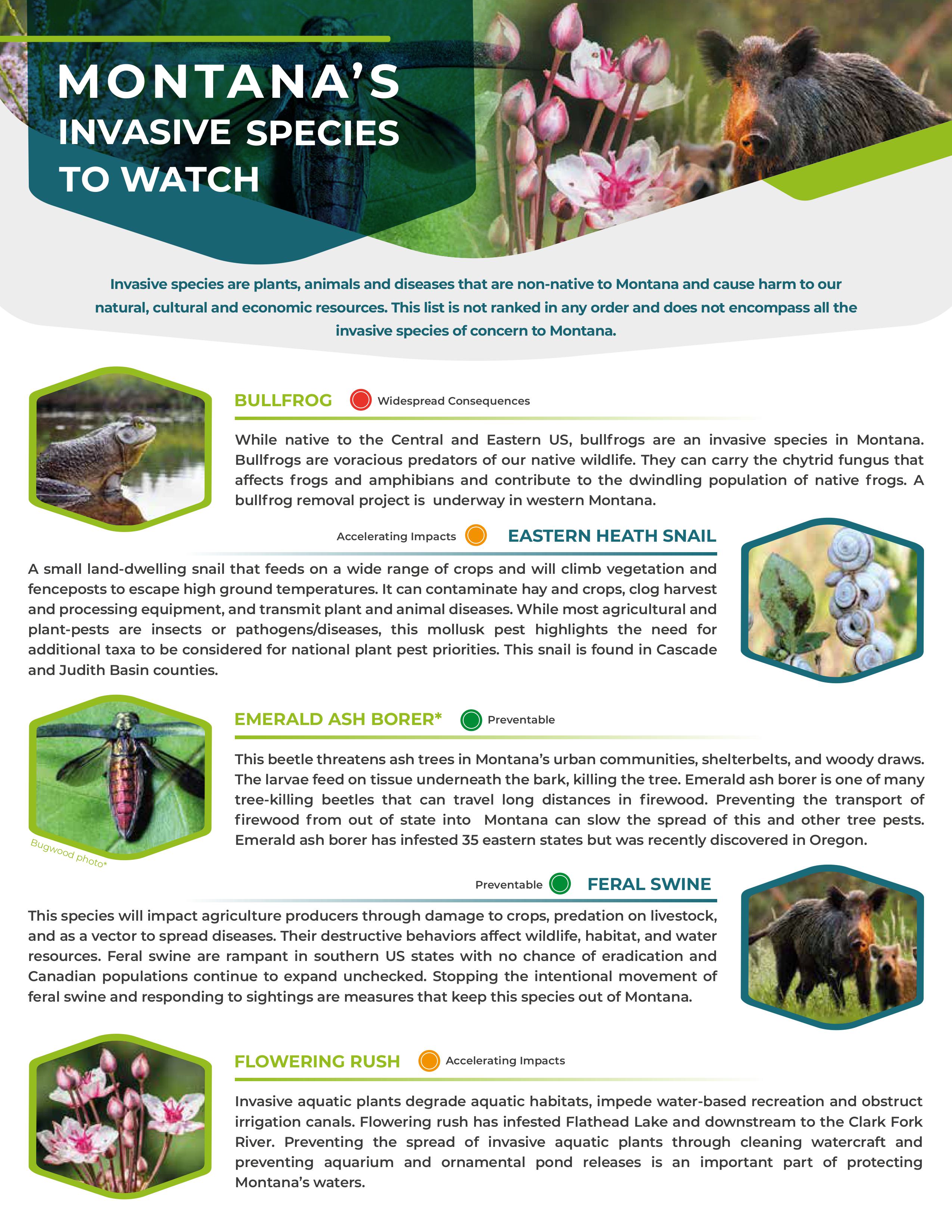Montana's Invasive Species to Watch
Bullfrog: Widespread Consequences
While native to the Central and Eastern United States, Bullfrogs are an invasive species in Montana. Bullfrogs are voracious predators of our native wildlife. They can carry the chytrid fungus that affects frogs and amphibians and contributes to the dwindling population of native frogs. A Bullfrog removal project is underway in Western Montana.
Eastern Heath Snail
Eastern Heath Snail: Accelerating Impacts
A small land-dwelling snail that feeds on a wide range of crops and will climb vegetation and fenceposts to escape high ground temperatures. They can contaminate hay and crops, clog harvest equipment, and transmit plant and animal diseases. While most agricultural and plant pests are insects or pathogens/diseases, this mollusk pest highlights the need for additional taxa to be considered for national plant pest priorities. This snail has been found in Cascade County, Judith Basin County, and Fergus County.
Emerald Ash Borer: Preventable
This beetle threatens ash trees in Montana’s urban communities, shelterbelts, and woody draws. The larvae feed on tissue underneath the bark, killing the tree. The Emerald Ash Borer is one of many tree-killing beetles that can travel long distances in firewood. Preventing the transport of firewood from out of state into Montana can slow the spread of this and other tree pests. The Emerald Ash Borer has infested 35 eastern states but was recently discovered in Oregon.
Feral Swine: Preventable
This species will impact agriculture producers through damage to crops, predation on livestock, and as a vector to spread diseases. Their destructive behaviors affect wildlife, habitat, and water resources. Feral swine are rampant in southern US states with no chance of eradication and Canadian populations continue to expand unchecked. Stopping the intentional movement of feral swine and responding to sightings are measures that keep this species out of Montana.
Flowering Rush: Accelerating Impacts
Invasive aquatic plants degrade aquatic habitats, impede water-based recreation and obstruct irrigation canals. Flowering rush has infested Flathead Lake and downstream to the Clark Fork River. Preventing the spread of invasive aquatic plants through cleaning watercraft and preventing aquarium and ornamental pond releases is an important part of protecting Montana’s waters.
Rush Skeletonweed: Accelerating Impacts
A deep-rooted perennial noxious weed that is very drought resistant and can easily spread from rangeland to cropland. Impacts in rangeland include loss of forage and biodiversity. In croplands like cereal grains and potatoes, Rush Skeletonweed can reduce production, and quality, and hamper harvest machinery with sticky latex sap. Rush Skeletonweed is very difficult to identify in the field and management can be laborious. It is found mostly in western Montana.
Saltcedar: Accelerating Impacts
This tall woody shrub establishes in riparian areas and replaces large stands of native cottonwood and willows reduces wildlife access, increases soil salinity, and has the potential to take up significant amounts of water through a deep tap root. Saltcedar is a drought-tolerant species that spreads easily by wildlife and water. When it develops dense stands, it can alter stream channels and floodplains. Saltcedar is found along the Missouri and Yellowstone rivers and tributaries.
Zebra Mussels: Preventable
Invasive mussels can have major impacts on Montana’s waters. They disrupt the food chain and impact recreational boating and fishing. Mussels can cause significant damage to infrastructure by clogging pipes used for hydropower, irrigation, and water treatment plants. Zebra mussels are established in the Dakotas and other eastern states. Preventing the spread of invasive mussels by cleaning watercraft and equipment is a top regional priority.
Ventenata: Accelerating Impacts
A noxious winter annual grass which can impact Montana’s native landscapes and degrade rangelands, pastures, and crops by decreasing agricultural production and increasing the risk of soil erosion. Ventenata has little to no forage value and its diminutive stature makes it difficult to identify. Ventenata is found from northwestern through southcentral and southeastern Montana.


